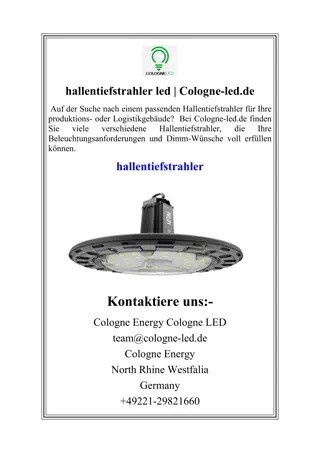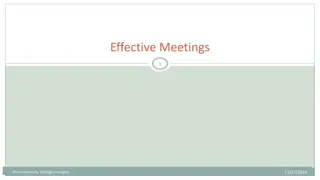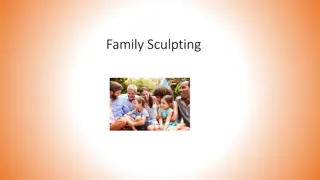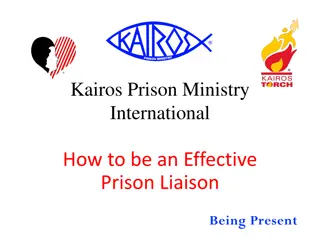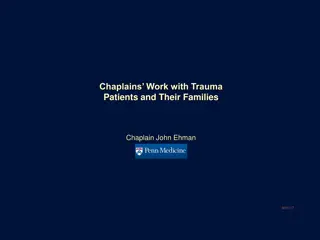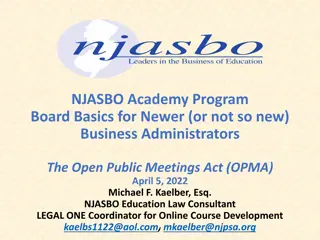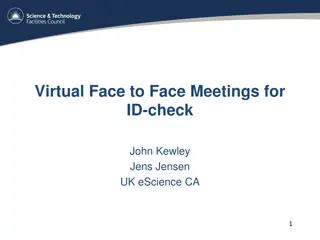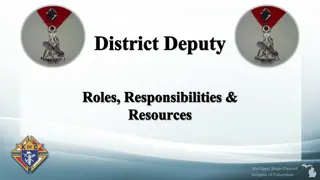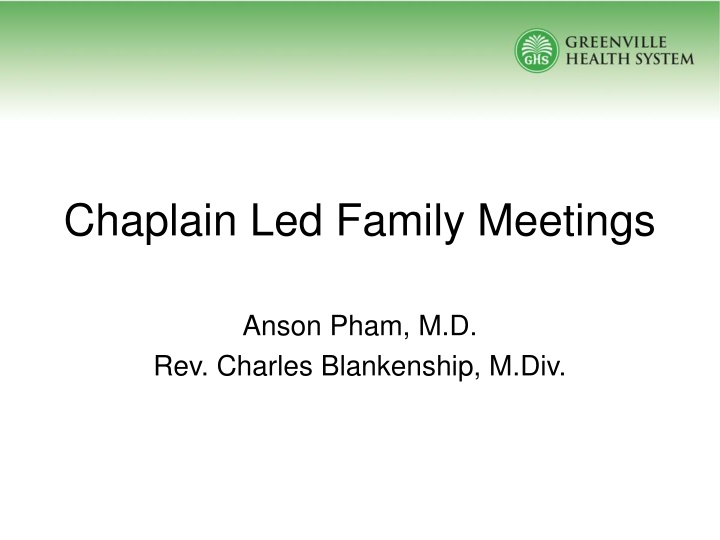
Palliative Care and Hospice: Key Differences and Benefits
Discover the distinctions between Palliative Care and Hospice, as well as the essential aspects of leading family meetings in a healthcare setting. Learn about the specialized care and support offered to individuals facing serious illnesses and how to effectively communicate with patients and their families. This comprehensive guide provides insights into the principles, goals, and practices of a Palliative Care division within a hospital context.
Download Presentation

Please find below an Image/Link to download the presentation.
The content on the website is provided AS IS for your information and personal use only. It may not be sold, licensed, or shared on other websites without obtaining consent from the author. If you encounter any issues during the download, it is possible that the publisher has removed the file from their server.
You are allowed to download the files provided on this website for personal or commercial use, subject to the condition that they are used lawfully. All files are the property of their respective owners.
The content on the website is provided AS IS for your information and personal use only. It may not be sold, licensed, or shared on other websites without obtaining consent from the author.
E N D
Presentation Transcript
Chaplain Led Family Meetings Anson Pham, M.D. Rev. Charles Blankenship, M.Div.
Presentation Goals Define the Differences between Palliative Care and Hospice Discuss the basics of preliminary preparations for leading a family meeting Describe the basics of leading a family meeting Discuss simple communication tools to assist in communicating with the seriously ill patient and their family
Our Context Greenville Memorial Hospital (Inpatient) Palliative Care Division in the Department of Medicine MD (5), NP (2), Nurse Coordinators (3), Social Workers (4), Chaplains (3), Admin. (4) Patient Census 30 60 patients (High: 71). 995 beds on our campus.
What is Palliative Care? Specialized care for people living with serious illness Relief from the pain, symptoms, and stress of a serious illness Support for patient and family Appropriate at any age and at any stage in a serious illness Reference: CAPC website https://www.capc.org/about/palliative-care/
Palliative Care Defined A partnership between the patient, carers [caregivers], and various professionals. It affirms life and regards dying as a normal process, neither hastening nor postponing death. It integrates the psychological, physical, social and spiritual aspects of a patient s care. Carter, and Richard Woof (Malden, MA: Blackwell Science, Inc., 1998), 3. Handbook of Palliative Care, eds., Christina Faull, Yvonne
Palliative Care Defined Palliative Care, as defined by the World Health Organization, is an approach that improves the quality of life of patients and their families facing the problems associated with life-threatening illness, through the prevention and relief of suffering by means of early identification and impeccable assessment and treatment of pain and other problems, physical, psychosocial, and spiritual
A Big question Are Palliative Care and Hospice Care the same thing? HOSPICE HOSPICE PALLIATIVE CARE PALLIATIVE CARE Terminal illness Life expectancy of 6 months or less Patient/family chooses NOT to receive continued aggressive, curative care Focuses on comfort versus cure Ideally begins at the time of diagnosis of a serious illness No life expectancy requirement Can be provided at any age and any stage in a serious illness Can be provided at the same time as curative, aggressive care
General Information on Family Meetings
Why Have a Family Meeting? Informational Delivering Bad News Establish Goals of Care Decide on specific interventions When patient admitted Status Change When Family Requests One Uptodate: Communication in the ICU: Family meeting
Why Have a Family Meeting? According to an observational study of 102 patients, only half of the families understood the patient's diagnosis, prognosis, or treatment after an initial meeting with an attending clinician. Half the families of intensive care unit patients experience inadequate communication with physicians. Azoulay E1, Chevret S, Leleu G, Pochard F, Barboteu M, Adrie C, Canoui P, Le Gall JR, Schlemmer B. Crit Care Med. 2000 Aug;28(8):3044-9
Why Have a Family Meeting? In a study of 81 decision-makers, most reported excellent comprehension, but only one-half had a good understanding when objectively tested. A prospective study of primary surrogate decision makers' knowledge of intensive care.Rodriguez RM1, Navarrete E, Schwaber J, McKleroy W, Clouse A, Kerrigan SF, Fortman J. Crit Care Med. 2008 May;36(5):1633-6. doi: 10.1097/CCM.0b013e31816a0784.
Why Have a Family Meeting? Family members who are present at the time of death or who perceived that communication was inadequate are at increased risk for PTSD symptoms Predictors of symptoms of posttraumatic stress and depression in family members after patient death in the ICU.Gries CJ1, Engelberg RA, Kross EK, Zatzick D, Nielsen EL, Downey L, Curtis JR. Chest. 2010 Feb;137(2):280-7. doi: 10.1378/chest.09-1291. Epub 2009 Sep 17.
What is the evidence on timing? At least one study looking at within 72 hours of admission Can decrease length of stay with no change in mortality An intensive communication intervention for the critically ill. Lilly CM1, De Meo DL, Sonna LA, Haley KJ, Massaro AF, Wallace RF, Cody S. Am J Med. 2000 Oct 15;109(6):469-75.
Goal Setting What are goals of care? What is the patient trying to accomplish with treatment? Cure or life prolonging measures? Pain control? What can be accomplished with treatment? Palliative chemotherapy? CPR in end stage disease processes (i.e. end stage heart failure, end stage COPD, end stage dementia)?
Goal Setting Allow enough time after each question Use follow up questions as needed especially if clarification is needed Discuss big picture goals before discussing specific interventions Restate goals to be sure both you and the family fully understand each other o What I hear you saying is you want to be home, comfortable, and survive until your grandson is born.
Capacity Similar to informed consent (determined by physician) Patient should know: Diagnosis The nature, purpose, risks and benefits of a proposed treatment or procedure The nature, purpose, risks and benefits of alternative treatments or procedures The risks and benefits of not receiving or undergoing a treatment or procedure PC fast facts #164
Family Meeting if Patient Lacks Capacity Identify surrogate decision maker o Guardian, HCPOA, Family Decision Making o Advance directives o Substituted judgement o Best interests
Family Meeting if Patient Lacks capacity Clinician should share responsibility and make recommendations based on knowledge of patient s values and patient s current condition o Given what you have told me regarding your mom and her current condition I would recommend Best interest should be used along with substituted judgement o I know your sister is a fighter but she is suffering a lot and unfortunately we cannot fix what is wrong with her, so we should consider stopping dialysis.
Chaplain Led Family Meetings
Pre-Meeting Prep. Be a Student of your Process Know your Team (What are they Bringing) Know Yourself (What are you Bringing) Know your Patient (Actually Visit Them) Know your Patient (Know the Chart) Know your Patient s Family
Pre-Meeting Prep Leading family meetings and/or effectively growing and maintaining healthy palliative care teams begins with understanding how to grow professionally in at least three areas: Role Building Education Case Building Education Team Building Education
Pre-Meeting Prep. Incredibly helpful Articles: 7x7 Model for Spiritual Assessment by George Fitchett. (A chaplain once referred to Fitchett as the Sigmund Freud of Chaplaincy). A Case Builder. The Healing Family by Stephanie Matthews Simonton. Helping vs. Rescuing. A Role Builder. The Dying Role Journal of Palliative Medicine Vol. 10, Number 1, 2007. A Role Builder.
Pre-Meeting Prep. Incredibly helpful Articles: The Relief of Existential Suffering by David W. Kissane, M.D. ARole Builder. Asking the Right Question about Pain: Narrative and Phronesis Arthur W. Frank. A Case Builder. Role of the Doctor in Relieving Spiritual Distress at the End of Life by Karen Pronk. A Team Builder.
Why Chaplain Led Family Meetings? Does Spirituality / Religion Drives perspective on their medical condition? Does the patient and/or family use a lot of spiritual language? Faith Hope Miracle Fighter Prayer
Family Meetings and Guiding Tools Curiosity What are you wondering about? Thinking What are you thinking about? Barriers What is preventing the patient from reaching their goal? Pace How fast or how slow is the conversation moving? Weaving in and out (Medical to Spiritual to Medical again) But, does the family and/or patient view the world through a spiritual / religious lens? This is translation! Reframing Miracle Language Patient Advocacy Family may say, I know what he/she would want, but I m going to do ___________ anyway.
Case Study 50 year old male admitted with persistent cough with blood, anemia and weight loss. Patient is accompanied by wife and son. Physician has called for a family meeting. A chaplain is present for the meeting.
Perspectives Physician - What is your goal? - What do you find most distressing about this situation? - What is your fear?
Perspectives Family - What is your goal? - What do you find most distressing about this situation? - What is your fear?
Perspectives Patient - What is your goal? - What do you find most distressing about this situation? - What is your fear?
Perspectives Chaplain - What is your goal? - What do you find most distressing about this situation? - What is your fear?
Role Play 79 year old male with moderate to severe dementia. Patient cannot swallow and is aspirating on his secretions. Patient is now non-verbal and cannot make his own decisions. Wife is next of kin.
Case Study 1 92 year old female with past medical history of coronary artery disease status post 2 bare metal stents, diabetes, 2 strokes, and end stage dementia admitted with sepsis secondary to aspiration pneumonia. This is her 5th admission for similar reasons. She lives in a nursing home. Her baseline is being able to follow simple commands and tolerate movement in wheelchair but cannot walk and cannot propel herself in the wheelchair. She requires assistance with most activities of daily living.
She has been intubated for approximately 2 weeks. The patient currently blinks in response to name but does not follow commands or track movements. A family meeting is arranged to discuss feeding tube and tracheostomy. Patient is still full code. Patient s decision maker is her husband who is 95 and cognitively impaired, but wants eldest daughter involved.
Discussion Time 1. 2. 3. their goal? 4. Religious implications? Any other details you need? What are you thinking about? What is preventing the patient from reaching
Case Study 2 32 year old with past medical history of diabetes, hypertension, hyperlipidemia, Graves disease, coronary artery disease, End Stage Renal Disease on peritoneal dialysis admitted with altered mental status and shock. Patient has been admitted at least 11 times in the past year with complications from diabetes.
Patient is currently awake and alert and oriented x 3 but does not have very good understanding about their disease process. Patient is accompanied by her parent who has not been involved in her care for the past 10 years due to incarceration. Patient s health continuing to decline and patient and parent insists on being full code and doing everything.
Discussion Time 1. 2. 3. their goal? 4. Religious implications? Any other details you need? What are you thinking about? What is preventing the patient from reaching
References How I conduct the family meeting to discuss the limitation of life-sustaining interventions: a recipe for success. DeLisser. Blood 2010 116:1648-1654; doi: https://doi.org/10.1182/blood-2010-03-277343 Half the families of intensive care unit patients experience inadequate communication with physicians. Azoulay E1, Chevret S, Leleu G, Pochard F, Barboteu M, Adrie C, Canoui P, Le Gall JR, Schlemmer B. Crit Care Med. 2000 Aug;28(8):3044-9. A prospective study of primary surrogate decision makers' knowledge of intensive care.Rodriguez RM1, Navarrete E, Schwaber J, McKleroy W, Clouse A, Kerrigan SF, Fortman J. Crit Care Med. 2008 May;36(5):1633-6. doi: 10.1097/CCM.0b013e31816a0784. Understanding cardiopulmonary resuscitation decision making: perspectives of seriously ill hospitalized patients and family members. Heyland DK1, Frank C, Groll D, Pichora D, Dodek P, Rocker G, Gafni A. Chest. 2006 Aug;130(2):419-28. Primer of Palliative Care. Quill TE, Holloway RG, et.al. American Academy of Hospice and Palliative Medicine, Illinois, 2010. Back AL. Arnold RM, Quill TE. Hope for the Best, and Prepare for the Worst. Ann Intern Med. 2003;138:439- 443. Quill TE, Arnold RM, Platt F. I Wish Things Were Different : Expressing wishes in response to loss, futility and unrealistic hopes.. Ann Intern Med. 2001.135:551-555. Hudson P, Quinn K, O Hanlon B, Aranda S. Family meetings in palliative care: multidisciplinary clinical practice guidelines. BMC Palliat Care. 2008;7:12.


